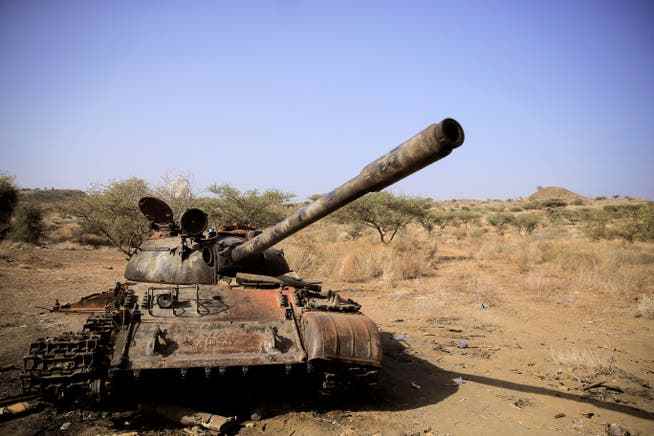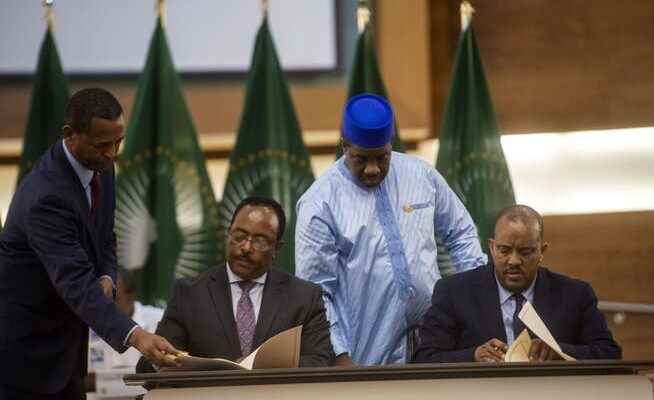The war in the Ethiopian region has cost hundreds of thousands of lives. An agreement negotiated in Pretoria could be the beginning of the end – but the hurdles remain high.
Peace soon? Redwan Hussien, representative of the Ethiopian government, and Getachew Reda, representative of the Tigrinya side, in Pretoria on Wednesday.
The warring factions in Tigray agreed to a ceasefire on Wednesday – almost two years to the day to the day after a brutal civil war began that has so far claimed the lives of around half a million people and more two and a half million expelled.
The handshake between representatives of the Ethiopian government and the Tigrinya ruling party Tigray People’s Liberation Front (TPLF) follows ten days of talks in the South African capital of Pretoria. A joint two-page statement read: “We have agreed to permanently silence the guns and end two years of conflict in northern Ethiopia.” The talks in South Africa were organized by the African Union (AU); the USA, which has been increasingly committed to a solution to the conflict this year, was an observer.
The ceasefire comes as a surprise because fighting in Tigray has escalated in recent weeks. The Ethiopian army, together with allied troops from neighboring Eritrea, had conquered areas and strategically important places. Some observers believed that the government side could succeed in taking the Tigrinya capital, Mekele.
There were also doubts about the chances of success of the talks in South Africa because secret talks mediated by the United States had failed in the first half of 2022 and because the African Union had acted with little sovereignty. A first attempt at talks in South Africa had to be postponed because the AU had scheduled it at such short notice that participants could not travel.
Five million people need help
However, the agreement is likely to have come about because the two most important parties to the conflict also have strong incentives to end the war. The Ethiopian army has suffered heavy casualties in its advance into Tigray, and the further it advances, the more difficult it is for them to maintain logistics. Prime Minister Abiy Ahmed’s government is also under pressure because the country’s economic situation is steadily deteriorating and it is in urgent need of international aid, which has been suspended due to the war.
The Tigrinya side, in turn, wants to end a humanitarian catastrophe that has caused a blockade that has existed for almost a year and a half. Banking, electricity and internet connections have been interrupted, and humanitarian goods have hardly reached Tigray in recent weeks because of the fighting that has broken out again. Five of the approximately eight million people in the region are in urgent need of food aid.
The exact extent of the war in Tigray and its aftermath is unclear because the Ethiopian government has denied access to journalists since the blockade began. Information comes from employees of humanitarian organizations, diplomats and individual statements from Tigrinya, who get out.

An Ethiopian Army tank destroyed in battles with the Tigrinya troops in the Afar region.
What is Eritrea doing?
The statement, which was published on Wednesday, is intended to pave the way for a more comprehensive one agreement, which the parties have drafted but apparently not yet signed. In the Explanation Among other things, it says that the parties have negotiated a program under which the TPLF fighters are to be demobilized and disarmed. It is also mentioned that access for humanitarian aid should be facilitated.
The ceasefire is the biggest step so far to end one of the worst wars that have been fought in Africa in recent decades. But many question marks remain. One of the biggest is the role of Eritrea. Ethiopia’s northern neighbor, which shares a border with Tigray, has been involved in the war from the start. Eritrean troops are blamed for some of the worst crimes, including mass rapes and massacres of civilians. Eritrean dictator Isaias Afewerki harbors a bitter enmity with the TPLF and sees the war as an opportunity to eliminate them. Eritrean troops are deep in Tigray but are not mentioned in Wednesday’s statement. It is unclear – and doubtful – whether Afewerki will agree to a peace deal.
Territorial disputes will be a major obstacle in further negotiations. For example, western Tigray has been occupied by troops from the neighboring region of Amhara for almost two years. Amharic politicians make a claim to the region that they establish historically.
In the longer term, too, it will be difficult to reintegrate Tigray and its people into the Ethiopian state. The war has deepened existing social rifts, Tigrinya have become the target of persecution outside their region of origin, and thousands have been imprisoned. Many of them want independence.
Prime Minister Abiy Ahmed hailed the Pretoria agreement as “monumental” despite these difficulties. Others were more cautious. AU special envoy Olusegun Obasanjo said: «This moment is not the end of the peace process. He is the beginning.”
